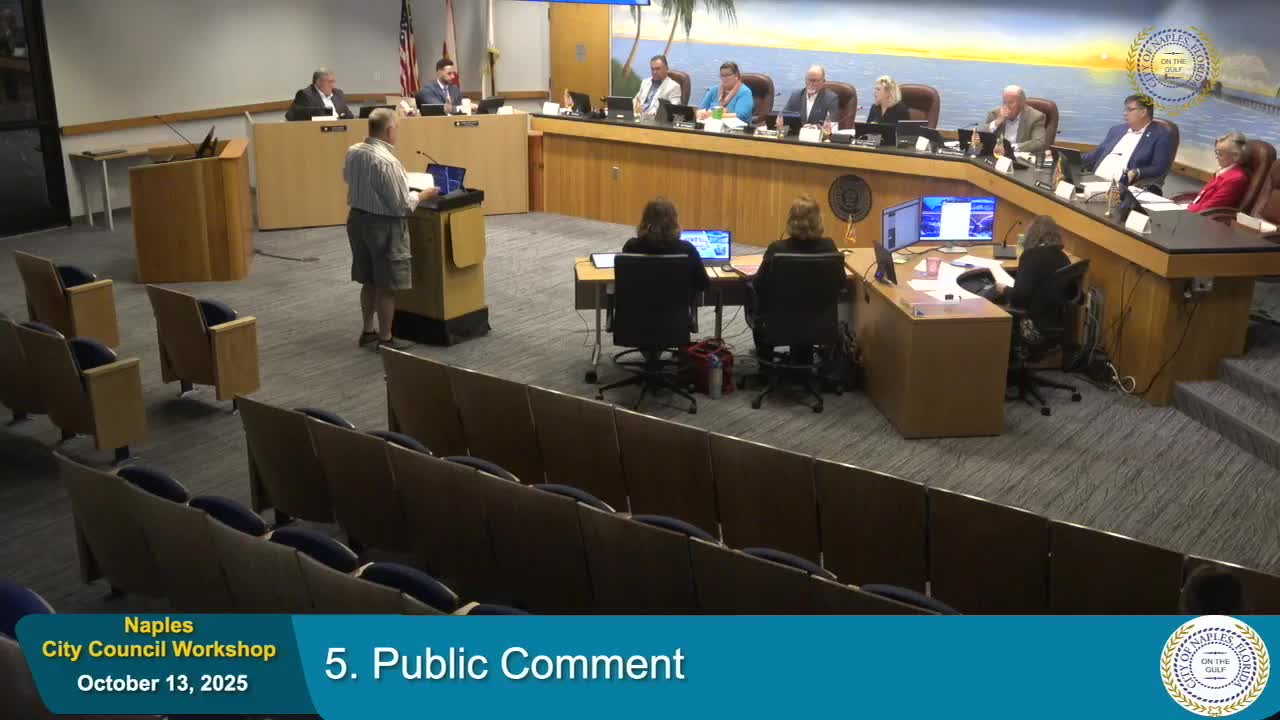AECOM analysis estimates billions in coastal storm risk for Naples; seawall elevation and freeboard options show positive benefit-costs
October 13, 2025 | Naples, Collier County, Florida
This article was created by AI summarizing key points discussed. AI makes mistakes, so for full details and context, please refer to the video of the full meeting. Please report any errors so we can fix them. Report an error »

AECOM presented a city-funded “business case for resilience” at the Oct. 13 workshop, quantifying the potential cost of inaction from coastal storms, compound flooding and daily high tides, and modelling adaptation options including seawall elevation and building freeboard.
Annie DeBoer of AECOM said the team modelled existing, 2040 and 2070 hazard conditions using NOAA sea‑level curves and applied depth-damage functions to city parcel data, building replacement values and business interruption estimates. The analysis separated temporary event damages (coastal storms and compound rainfall-and-tide events) from long-term impacts due to daily tidal inundation where more than 25% of a building footprint was exposed.
Key results: AECOM’s desktop analysis estimated the average direct property impact for a 100‑year coastal storm would grow from roughly $320 million in a 2040 intermediate scenario to several billion dollars by 2070 in higher sea-level scenarios; compound-flood events showed substantial per‑event losses as well. AECOM also reported daily high‑tide exposure that could place tens to hundreds of millions of market value at risk under higher-rise scenarios by 2070.
On adaptation, AECOM tested three strategies: (1) adding a second foot of freeboard for new single-family residences inside the Special Flood Hazard Area; (2) flood‑proofing commercial buildings outside the SFHA; and (3) elevating bayfront seawalls. Results showed the following: modest freeboard increases for new homes have low upfront cost and produce positive benefit-cost ratios when adopted now and measured over time; flood‑proofing commercial buildings outside the SFHA showed costs higher than modeled benefits; and elevating vulnerable bayfront seawalls produced benefit-cost ratios from about 1.8 to higher depending on the scenario and cost assumptions.
AECOM noted the analysis was a high-level desktop exercise using available public data and assumptions about first-floor elevations and building values, and that some benefits were not monetized (public health, tourism disruptions, ecosystem services). The firm also presented regional economic modelling showing the county gross regional product impacts of a coastal storm hitting Naples could range from the tens of millions in 2040 to hundreds of millions or more by 2070.
Councilmembers asked for follow-up on how to convert the findings into practical policy and code choices, whether building‑code freeboard changes would trigger building‑height conflicts, and how seawall elevation would be financed. City staff said the resilience business case will be used alongside the comprehensive‑plan update and shoreline policy work to shape priority actions and funding requests.
AECOM next steps: finalize technical report and brochure, and provide more granular costing and phasing to inform council choices.
Annie DeBoer of AECOM said the team modelled existing, 2040 and 2070 hazard conditions using NOAA sea‑level curves and applied depth-damage functions to city parcel data, building replacement values and business interruption estimates. The analysis separated temporary event damages (coastal storms and compound rainfall-and-tide events) from long-term impacts due to daily tidal inundation where more than 25% of a building footprint was exposed.
Key results: AECOM’s desktop analysis estimated the average direct property impact for a 100‑year coastal storm would grow from roughly $320 million in a 2040 intermediate scenario to several billion dollars by 2070 in higher sea-level scenarios; compound-flood events showed substantial per‑event losses as well. AECOM also reported daily high‑tide exposure that could place tens to hundreds of millions of market value at risk under higher-rise scenarios by 2070.
On adaptation, AECOM tested three strategies: (1) adding a second foot of freeboard for new single-family residences inside the Special Flood Hazard Area; (2) flood‑proofing commercial buildings outside the SFHA; and (3) elevating bayfront seawalls. Results showed the following: modest freeboard increases for new homes have low upfront cost and produce positive benefit-cost ratios when adopted now and measured over time; flood‑proofing commercial buildings outside the SFHA showed costs higher than modeled benefits; and elevating vulnerable bayfront seawalls produced benefit-cost ratios from about 1.8 to higher depending on the scenario and cost assumptions.
AECOM noted the analysis was a high-level desktop exercise using available public data and assumptions about first-floor elevations and building values, and that some benefits were not monetized (public health, tourism disruptions, ecosystem services). The firm also presented regional economic modelling showing the county gross regional product impacts of a coastal storm hitting Naples could range from the tens of millions in 2040 to hundreds of millions or more by 2070.
Councilmembers asked for follow-up on how to convert the findings into practical policy and code choices, whether building‑code freeboard changes would trigger building‑height conflicts, and how seawall elevation would be financed. City staff said the resilience business case will be used alongside the comprehensive‑plan update and shoreline policy work to shape priority actions and funding requests.
AECOM next steps: finalize technical report and brochure, and provide more granular costing and phasing to inform council choices.
View full meeting
This article is based on a recent meeting—watch the full video and explore the complete transcript for deeper insights into the discussion.
View full meeting